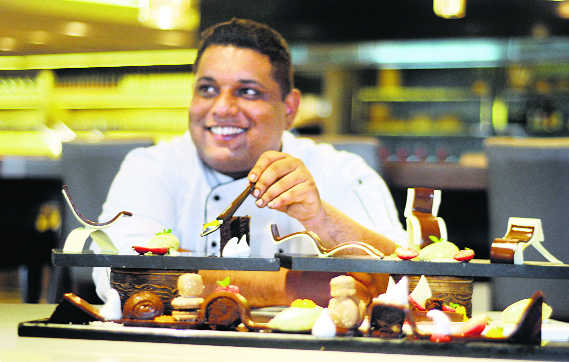Molecular gastronomy, which converts simple ingredients into caviar look- alike balls, is the latest technique to sweep the professional kitchens
Gurvinder Singh
Astronomy is the science of shining balls in the space. Gastronomy is the art of creating all that on plate. Molecular gastronomy is the art and science of creating the shiny balls on plate. This may be a simplistic take on molecular gastronomy, but its culinary experience is nothing shy of sophisticated, scrumptious and sublime.
Welcome to the world of molecular gastronomy where the flavours titillate, aesthetics elate, and the senses of sight and taste celebrate.
Like magic, it transforms the original ingredients that go unnoticed in dishes into shapes and sizes that have their own beauty, their own aesthetic existence and yet retain their authentic taste and value.
Chef Vibhor Shahi is busy lending such a makeover to mango pulp, strawberry pulp, orange juice and balsamic vinegar. He is transforming these into ‘caviars’. Though caviars are created from eggs of salmon roe fish and its family, but we can create caviars look-alikes from any fruits, juices and other food items. “These have the original taste of the food, but have the texture and shape of caviars, which are like small shiny balls,” says the chef.
In molecular gastronomy, the nutritional value of food doesn’t change. It is rather preserved, just the texture changes, he says. So, the original ingredients that are not generally changed, but these can be presented in very different look and manner. For example, just mango pulp can be given a hard texture like rock, or liquid, semi-solid, or semi-liquid, or dry texture. It can also be made into powder, apart from the caviar, he says.
Chef Shahi turns chocolate ganache, which is gooey and is not consumed all alone, into pliable strips that not only look all the more delectable, but provide the chef the infinite opportunity to present and play with the new texture of the ganache. “It looks stunningly beautiful,” he says.
He is no less than a scientist. Ask about the ingredients generally used in molecular gastronomy, and he reels off many—aggar agar, hydrocollide, liquid nitrogen, ultra tex, ultra sperse, NH Pectin, Calcium lactate, carboxy methyl celulus, sodium alignate, malto dextrin, caregenin (iota and cupa varieties), versewhip, ultratex, conjac, xanthan gum. “These are not chemicals, but edible ingredients. Many of these help in giving a new texture to the food,” he says.
And it is not possible without equipment, including gellan, anti-griddle, vapourizer, caviar dropper, smoking gun and more. “But these processes are not possible without experience, understanding of the process, equipment and correct calculation. Measurements matter in cooking, but these are essential in molecular gastronomy,” he said.
“Molecular gastronomy is like a magic wand in the hand of a chef, as anything and everything can be presented interestingly and differently,” he says.
He places his ganache, created in varied presentations of strips and the colourful caviars that allure the eyes and taste superb.
Unlock Exclusive Insights with The Tribune Premium
Take your experience further with Premium access.
Thought-provoking Opinions, Expert Analysis, In-depth Insights and other Member Only Benefits
Already a Member? Sign In Now










